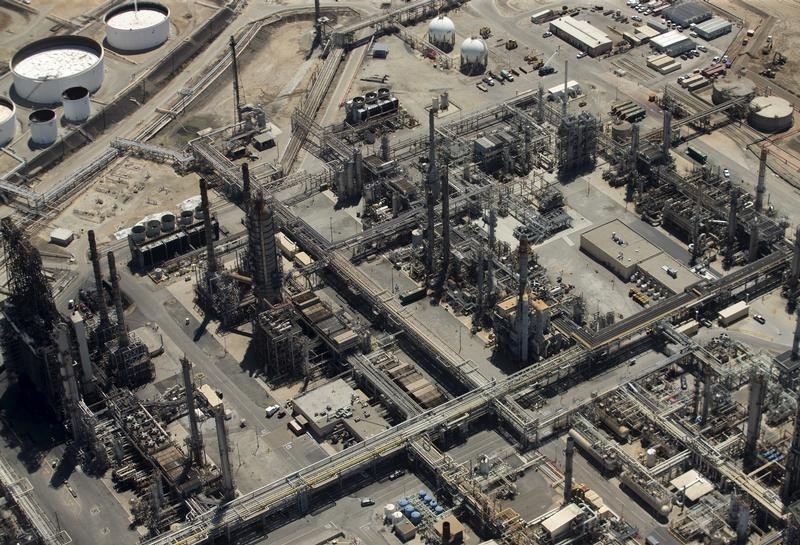By Muyu Xu
SINGAPORE (Reuters) – Asian refiners are on the hunt for to replace Kuwaiti supply as the OPEC producer cuts exports by nearly a fifth to feed its huge new refinery, which is driving up prices for other sour crudes and likely to squeeze profit margins.
Lower Kuwaiti exports follow cuts from OPEC kingpin Saudi Arabia that have pushed Brent prices close to $90 a barrel and left little wriggle room for Asia’s refiners, reliant on the Middle East for more than two-thirds of crude imports.
Chinese refiners, which have invested heavily in new plants designed to process sour oil, are especially exposed.
Discounted oil from Russia has eased some of the pain, replacing some Kuwaiti supply, largely to China and India.
But most of Kuwait’s customers will have to pay up for similar quality oil from other suppliers such as Saudi Arabia, Iraq and the United Arab Emirates or buy more expensive sweet grades from other regions.
“Saudi Arabia and the UAE are the top contenders for filling the supply gap in the Middle East due to their production and export of medium sour barrels,” said Janiv Shah, an analyst at consultancy Rystad Energy.
“It is improbable that they will be able to entirely meet the demand.”
Sustained output cuts from OPEC producers and their allies and new refining capacity designed to process sour crude could lead to tight supply until the end of 2024, Energy Aspects analyst Sun Jianan said.
Kuwait’s crude shipments shrank by about 10% to 1.61 million barrels per day (bpd) in January-July from the same period in 2022 as its Al Zour refinery ramped up, according to Kpler data.
Exports to Taiwan, China and India dropped more than 17% during the same period, while volumes for Pakistan, the Philippines and Thailand fell to zero, the data showed.
In the second half, Kuwait will reduce its exports by up to 300,000 bpd, down 18% from the first half, as it diverts supply to the 615,000 bpd Al Zour plant, which cranked up its third and final crude distillation unit (CDU) in July, according to consultancies FGE, Energy Aspects, Rystad Energy and S&P Global (NYSE:) Commodity Insights.
Additionally, Kuwait’s joint venture 230,000 bpd Duqm refinery in Oman is scheduled to start operation by end-2023, which could reduce Kuwaiti crude exports by a further 100,000 bpd to 200,000 bpd in 2024, the consultancies said.
Kuwait Petroleum Corp (KPC) has notified buyers that volumes could fluctuate each month and could be further reduced once Al Zour is at full operation, a source familiar with the matter said.
KPC did not respond to Reuters’ inquiry seeking comment.
THIRSTY REFINERS
The supply squeeze comes as over 1 million barrels per day (bpd) of new Chinese refining capacity comes online. The 320,000-bpd Shenghong refinery and PetroChina’s 400,000-bpd Guangdong plant started commercial operations earlier this year, while Yulong Petrochemical’s 400,000-bpd refinery is scheduled to start trial runs in the fourth quarter.
“Almost all refineries in China are designed to process mainly medium sour crude oil,” said a Chinese oil trader, adding that tight supply would depress margins at Chinese refineries already struggling with tepid product demand.
Exports to key buyers – China, Japan, South Korea, India and Taiwan – are expected to drop further from October once Kuwait resumes supply to its Vietnam joint venture Nghi Son refinery following two months of scheduled maintenance work.
“The supply reduction in 2023 was factored in our term contract discussed last year,” KY Lin, spokesperson at Taiwan Formosa Petrochemical Corp said, adding that negotiations for 2024 supply will commence soon.
Formosa could replace Kuwaiti supply with grades such as Iraq’s Basra Medium, Qatar’s al-Shaheen and Oman crude, Lin said, adding it can also process U.S. light sweet crude.
PRICES CLIMB
Middle East crude exports are expected to slump by nearly 8%, or up to 1.35 million bpd, in the second half of 2023 from the first half, said James Forbes, an analyst at FGE.
Refiners are already feeling the pinch as Middle East producers have hiked official selling prices (OSPs) for July to September supplies.
In signs supply is tightening, in August, benchmark Dubai’s first month was trading $2.11 a barrel higher than the third month, compared with a difference of $1.14 in June.
And the discount for sour Dubai crude against sweet has narrowed sharply to around $1 a barrel from nearly $6 at the start of the year and briefly even fetched a small premium to Brent in June.
“The Brent-Dubai spread has recently widened but we do see some potential to narrow again if Asian demand strengthens further,” said Shah.
Read the full article here













